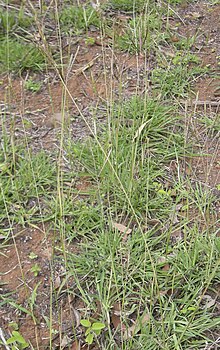| Bothriochloa | |
|---|---|

| |
| Bothriochloa pertusa | |
| Scientific classification | |
| Kingdom: | Plantae |
| Clade: | Tracheophytes |
| Clade: | Angiosperms |
| Clade: | Monocots |
| Clade: | Commelinids |
| Order: | Poales |
| Family: | Poaceae |
| Subfamily: | Panicoideae |
| Supertribe: | Andropogonodae |
| Tribe: | Andropogoneae |
| Subtribe: | Andropogoninae |
| Genus: | Bothriochloa Kuntze[1] |
| Type species | |
| Bothriochloa anamitica (syn of B. bladhii) | |
| Synonyms[2][3] | |
| |
Bothriochloa is a common and widespread genus of plants in the grass family native to many countries on all inhabited continents and many islands.[4] They are often called beardgrass, bluegrass or bluestem. Some species are invasive in areas where they have been introduced.[5][6]
The etymology of the genus name Bothriochloa derives from the two ancient Greek words βοθρίον (bothríon), meaning "small pit or trench", and χλόη or χλόα (khlóa), meaning "new green shoot or blade of grass".[7][8][9]
An specimens of Bothriochloa from Gooty Fort Hill, Andhra Pradesh, India was collected in December 2019 and identified as Bothriochloa ewartiana (Domin) C. E. Hubb. based on literature study and international correspondence with experts from Australia, Indonesia and Americas.[10] This study adds an extended and disjunct distribution of a Far Eastern species in Asia from India.[10]
- ^ Kuntze, Carl Ernst Otto 1891. Revisio Generum Plantarum 2: 762 description in Latin, commentary in German
- ^ a b Tropicos, Bothriochloa Kuntze
- ^ Kew World Checklist of Selected Plant Families
- ^ Watson L, Dallwitz MJ. (2008). "The grass genera of the world: descriptions, illustrations, identification, and information retrieval; including synonyms, morphology, anatomy, physiology, phytochemistry, cytology, classification, pathogens, world and local distribution, and references". The Grass Genera of the World. Retrieved 2009-08-19.
- ^ Jepson Manual Treatment
- ^ United States Department of Agriculture Plants Profile
- ^ Bailly, Anatole (1981-01-01). Abrégé du dictionnaire grec français. Paris: Hachette. ISBN 978-2010035289. OCLC 461974285.
- ^ Bailly, Anatole. "Greek-french dictionary online". www.tabularium.be. Retrieved October 8, 2020.
- ^ "Ellen Dorn, Native Plants of Arizona 2004, Bothriochloa barbinodis (Lag.) Herter". Archived from the original on 2015-04-02. Retrieved 2011-12-23.
- ^ a b Landge, Shahid Nawaz; Shinde, Rajendra D. (20 August 2021). "Synopsis of the genus Bothriochloa (Poaceae: Andropogoneae) in India". Phytotaxa. 516 (1): 43–58. doi:10.11646/phytotaxa.516.1.3. S2CID 238722563 – via Magnolia Press.